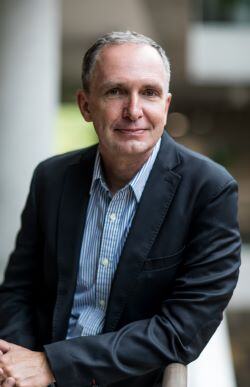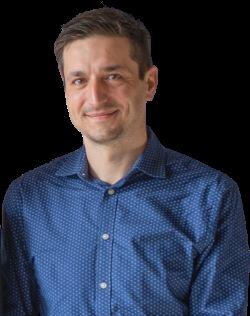Case Study: Use of BIM in ČSOB

In today's advanced societies, facility management is increasingly going digital, and the banking industry is no exception. The new ČSOB office buildings can be found in Prague and Hradec Králové in the Czech Republic. From its inception, the bank had the ambition to use the latest construction technologies in its facilities, one of which is BIM.
What is BIM?
Building information modeling (BIM) is the process of creating and managing data about a structure throughout its life cycle. BIM processes facilitate and define the way information exchange takes place during the design, construction and use phase, up to the demolition of the structure.
An information model is a digital model of a structure that refers to a database. It can be likened to a digital twin of a physical building.
With the implementation of BIM, it is possible to perform analyses and simulations on the virtual building as early as the initial design phase, thus helping to optimize the future operating costs of the operator from the start. The design phase allows for 3D views of all installations, such as heating, air conditioning, sanitary and other systems, to eliminate potential collision situations that would otherwise be difficult to address on site. Thanks to requirements to create handling spaces for technical equipment, it is possible to verify during the design phase that the space is not interfered with by the building structures or other utility lines. A prerequisite of a successful BIM implementation is that the information model is the sole source of data for all project participants who access the model.
Projects of new ČSOB buildings in Prague and Hradec Králové
ČSOB's aim has been to build up-to-date, flexible and environmentally friendly buildings for its staff.
The facility in Prague is designed as an office building for 1,400 people but doubles that in the number of alternative places to work. The building in Hradec Králové is designed for 1,050 people.
In the design of both structures, great emphasis was placed on the quality of the indoor environment, such as the amount of natural daylight, thermal comfort and interior acoustics.
The buildings themselves are distinguished by their unique energy concept. Facility heating and cooling is based on the principle of maximum use of resources from their surrounding environment. The buildings use heat pumps connected to borehole fields that are linked to a system of temperature-activated concrete ceilings. These provide staff with pleasant radiant heat in winter and welcome coolness in summer. The concept relies on the fact that in summer the surplus heat is stored in the ground and this energy is used by the building in winter and vice versa. The facilities do not need a conventional boiler room for their operation. Indoor thermal comfort is ensured in Prague by 173 geothermal boreholes with a depth of about 150 meters, and 107 geothermal boreholes in Hradec Králové with a depth of 200 meters. These are some of the largest geothermal pump systems in the Czech Republic.
Learning from experience
In 2006, ČSOB completed the construction of its first headquarters, at the time the largest administrative building in the Czech Republic. Building care was assigned to the facility management unit. Before the staff moved into the newly constructed building, ČSOB purchased a modular computer-aided facility management (CAFM) system. Building equipment was systematically labeled, and a list of equipment important for operation was created: the facility passport, which was imported into the CAFM system. By building on this elementary reference data, it was then possible to start and manage FM processes. However, an ex-post facility passport is time-consuming and uses up considerable funds. This experience shaped the further direction of FM at ČSOB, which now places even more emphasis on information with the aim of collecting data about a structure already in the design and implementation phases of construction projects. BIM helped achieve this goal.
BIM implementation concept for ČSOB
In 2014, ČSOB commissioned the BIM Implementation Concept for ČSOB, which set the goals and expectations of BIM implementation for FM. This concept won the 2014 Project of the Year Award from the Czech Republic Chapter of IFMA. The aim of the concept was to establish the principles and procedures for working with BIM in ČSOB with an emphasis on the use of the information model in FM both during construction and in subsequent operation of the building. The concept set out the procedures for how to collect data from all parties involved in construction projects, which emerge gradually as the project develops. This information is fed by the parties involved into the BIM model so that at the commissioning stage FM has all the information it needs to operate the building. To complement the existing 2D CAD standards that ČSOB used for example in its branch network, new BIM standards for designing in BIM have been added.
BIM manual for CAFM
A manual based on the BIM Implementation Concept for ČSOB became part of the assignment for architects and developers. With a clear idea of data needed to operate an office building, ČSOB prepared a fairly detailed brief in cooperation with the CAFM contractor and the design office. In the BIM manual, requirements for software tools, individual roles of BIM coordinators, project milestones and the elementary requirements of the BIM execution plan (BEP) were detailed and outlined. The BEP lays down specific rules for sharing the BIM model and the way for project participants to communicate between themselves. The BEP provides, among other things, the modeling standards, the numbering used for all elements and structures in the model, the specific versions of software tools, and specifies the requirements for the model's level of visual detail.
Ongoing BIM coordination meetings
Ongoing BIM coordination meetings throughout the project are used to check that the designer and contractor are fulfilling the requirements set out in the contract and BEP. Regular meetings allow for the early mitigation of deficiencies that would be difficult to eliminate later in the project. In the meetings, issues not provided for or not specifically addressed in the BIM manual for CAFM or BEP were resolved on an operative basis. During the design and implementation phases, ČSOB provided suggestions and comments on the model to ensure the highest possible quality of the BIM model.
As the project and the construction effort progressed, the model was gradually refined and enriched with visual and nonvisual data.
How can data from the BIM model be used in CAFM?
First, the data from the BIM model must be extracted and fed into the CAFM system. For data synchronization and export of 2D and 3D views, ČSOB uses an application program interface (API). This means that a CAFM plugin is installed in the BIM software, which then allows communication between the two applications. This communication can be bidirectional.
Step 1. Export of rooms, workplaces and technical equipment to the CAFM database
Prior to actual synchronization, it is necessary to set the bindings and synchronization direction between the databases. The bindings define which fields will be synchronized from BIM to CAFM. The initial synchronization direction is set from BIM to CAFM. For the export of technical equipment, it is essential to specify in detail which devices are to be transferred to the CAFM database.
Once the data of rooms, workplaces and technical equipment was in the database, this allowed:
- Creating scenarios for moving in staff from other buildings;
- The bulk release of meeting rooms to the booking system so that staff can plan their meetings or training sessions even while the rooms are not yet technically finished;
- Within the commissioning of the systems and actual acceptance of the building, users can record room deficiencies directly in the mobile CAFM application and to take the respective photo documentation – the output was a list of nonconformities, which was handed over to the contractor;
- Assigning each area in the room a cleaning frequency and prepare tender documents for service providers;
- Assigning templates for regular maintenance and revisions to technical equipment and its assemblies;
- Creating equipment-specific scheduled maintenance plans and track service history;
- Retrieving all operational data on technical equipment.
Step 2. Export of 2D and 3D views for CAFM
Thanks to suitably set up templates, simple views can be prepared for regular staff and more advanced views for specialists, in which it is possible to:
- Locate rooms, people and technical equipment in the building;
- Visually select the location for service requests;
- Extract data on building elements and technical equipment from the 3D model;
- Access documents such as technical data sheets, revisions and maintenance manuals directly from the BIM viewer in CAFM with just a few clicks.
Applying lessons learned from Prague to Hradec Králové
A building acceptance involves the investor assessing whether the contractor has implemented the project in accordance with the project documentation and in the required quality. For building acceptance in Hradec Králové, ČSOB did not use a mobile CAFM application as in the Prague project, but a mobile common data environment (CDE). The reason was that the CAFM they were using did not offer a suitable mobile solution for viewing the BIM model. Using suitably chosen CDE, an actual versus BIM status check was possible directly on site, and 3D views facilitated locating defects and imperfections in the spatial grid. Thanks to preconfigured workflows, these defects and imperfections were forwarded in real time, along with respective photographs, to the contractor for rectification. Both the contractor and the investor had an immediate overview of the number of defects awaiting redress at all times.
Experience from the BIM implementation at ČSOB
For a successful BIM implementation from an FM perspective, it is essential to know what data is needed to operate the building and who will be responsible for the data. Without proper software, powerful hardware, and the support of management and the team, a BIM project cannot be successfully implemented. Some people are naturally distrustful of new things; but if they fully understand the benefits, they can get as excited about BIM as the team at ČSOB did.
The information model must be kept up to date throughout the building lifetime; so, procedures need to be established for how the submitted actual design documentation will be updated. The FM staff must strictly follow the set procedures so that any changes in the facility are always entered into the information model.
Data in today's world has tremendous value, and its relevance and digitization is essential in every industry. We are clearly moving toward the axiom that all data must be stored electronically, structured and accessible from anywhere.
Awards won for the ČSOB building in Prague
- LEED Platinum New Construction certificate
- 1st place in the Financial Institutions category in the Office Facility of the Year 2019 competition
- Award from CZ BIM for the scope and use of the BIM technology in the Building of the Year 2019 competition
- 1st place in the administrative center category in the Best of Reality competition
- 1st place in the Best of Reality competition for environmentally friendly project
Awards won for the ČSOB building in Hradec Králové
- LEED Platinum New Construction certificate
- Award in the Hybrid Office of the Year category in the Office Facility of the Year 2022 competition
- 1st place in the administrative center category in the Best of Reality competition
- Special award for Environmental Project of the Year in the Best of Reality competition.

Daniel Rubricius, MBA graduated from the Faculty of Civil Engineering of the Czech Technical University in Prague, majoring in Ground Structures - Structural and Dynamic Analysis of Construction Systems. He has been with the ČSOB group since 2002 and is director of the FAM Buildings unit, in charge of comprehensive FM of ČSOB group's facilities, including the headquarters buildings in Prague and Hradec Králové. He is a member of IFMA’s Czech Republic Chapter’s board of directors.

Read more on Project Management , Technology and FM Solutions
Explore All FMJ Topics









